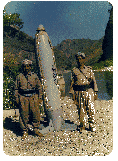







When the Gulf War began, I, like most Americans, knew little about the Kurds. My first visit to the region was brief. Pleased to have the Western press witness the Kurds' pressing need for humanitarian aid, Iran facilitated access to the Kurdish refugee camps. I was given a five-day visa, barely time to leave Paris, cross the Iranian border, and get to the "liberated" zone within northern Iraq. While the world's attention was concentrated on the flight of the Kurds, I was drawn to the places from which they'd come. I drove in along the same road upon which many Kurds were still fleeing. I was stunned by what I saw. I had never witnessed such a complete and systematic destruction of village life, even in ten years of covering the conflicts in Central America. . . .
Although few Western observers had been inside northern Iraq for nearly a decade, reports periodically leaked out through the Kurdish network about Saddam Hussein's 1988 "Anfal" campaign, a brutal attempt at annihilation. Nearly 100, 000 Kurds were said to have "disappeared." After reports that mass graves had been uncovered inside the Kurdish enclave, the group Human Rights Watch sent a mission into the territory to investigate. It was an opportune moment, since no one knew just how long it would take Saddam to regain military strength and reassert control over the region.
I was asked to join Dr. Clyde Snow, a forensic anthropologist well known for his exhumation of the mass graves in Argentina and Chile. My task was to photograph the sites of evidence, scars on survivors, unmarked graves, the clothes that had once wrapped bodies now buried anonymously, the bullet holes in skulls, the visible remains. That the Anfal campaign had ended three years before did not reduce the urgency with which we worked. I was part of an international team building a legal case against Saddam Hussein's brutality. Working with a small group of Kurds, we excavated where the gravediggers remembered burying the dead. Meticulously, earth was shoveled and then brushed away by hand, until finally the skull of a male teenager appeared, a synthetic cloth blindfold still wrapped around it. Needing no instruments, the experienced Dr. Snow measured the holes to determine range, caliber, type of weapon. He concluded that the boy was the victim of an execution.
These were not the first mass graves I had documented. This time, however, I was coming in at the end of the story. I had no connection to the Kurds and even less sense of why these killings had occurred. I felt strange, photographing the present while understanding so little about the past. Now I realize that the unearthing of these graves led me to years of further digging.
* * *
Some Kurds know a lot about those who passed through their lands over the last century. The names of Western travelers, missionaries, military officers, and colonial administrators float among the names of their own Kurdish heroes. My friend Bakhtiar Amin told me about a Major Noel, who in 1919 advised the British to be careful to distinguish between the Kurds and their Middle Eastern neighbors. Though Noel's diary could be found in the Public Record Office in London, it has only recently been published in Kurdish. Other Kurds told me that they had read some of the Western memoirs written about them. Dusty books, sparsely illustrated, long out of print, were taken off back shelves in their homes and proudly shown to me as treasured accounts. Thumbing through the pages, I thought about all the photographs that had been made and then taken away from Kurdistan.
I, too, have been such a traveler. I began to wonder where those early photographs were, imagining the route of their travel, carried by hand as glass or nitrate negatives, or shipped in trunks, to be pasted into albums or relegated to archives, or to disappear into attics. I wanted to retrace the paths of those earlier Western travelers and find the souvenirs and recollections of their journeys.
What interested me was the intersection and interplay between those who shaped Kurdish life and the lives of the chroniclers who pictured them, the photographers and those photographed, the points of cultural exchange, how the various protagonists crossed one another's paths. Both left their marks on Kurdish history.
* * *
Most of the images and written artifacts about the Kurds that survive, survive in the West. In part this is because the Kurds have little security and limited funds to maintain museums and libraries or to protect private collections. Ironically, interpretations of their culture offered by outsiders, missionaries, colonial administrators, and early travelers, have become indispensable sources of written and visual information.
Excerpts from diaries and documents make public what was often a personal record or private exchange. Suggesting the randomness by which history gets made, newspaper clippings and selected bits of memoirs reveal what was presented by the media and commonly believed at the time. Kurdish oral histories interspersed throughout contest the Western perspective of Kurdish life, as well as the view of the local regional powers. The book's design reproduces the images with all the markings of age and travel, so that the surface itself reveals the history of survival. I emphasize the photograph as object, as artifact, once held, now torn and stained. A photograph is a document that resists erasure. Rather than emerging as a completed puzzle with every piece fitting neatly together, this book project has revealed a mosaic, only from a distance is there a shape to discern. This is a reconstruction based on what remains and has been retrieved; we cannot know what is gone. Certainly, much is missing.
Excerpt from the Introduction to Kurdistan: In the Shadow of History, by Susan Meiselas, July 1998